
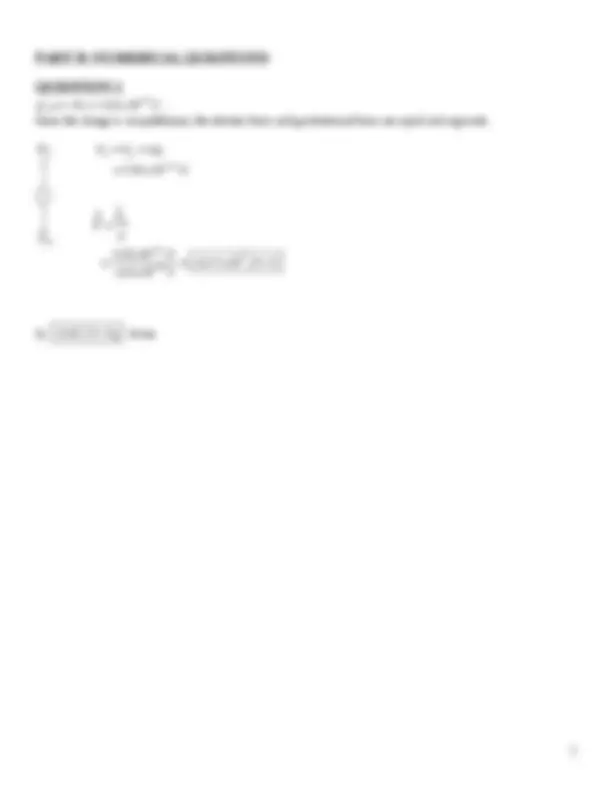
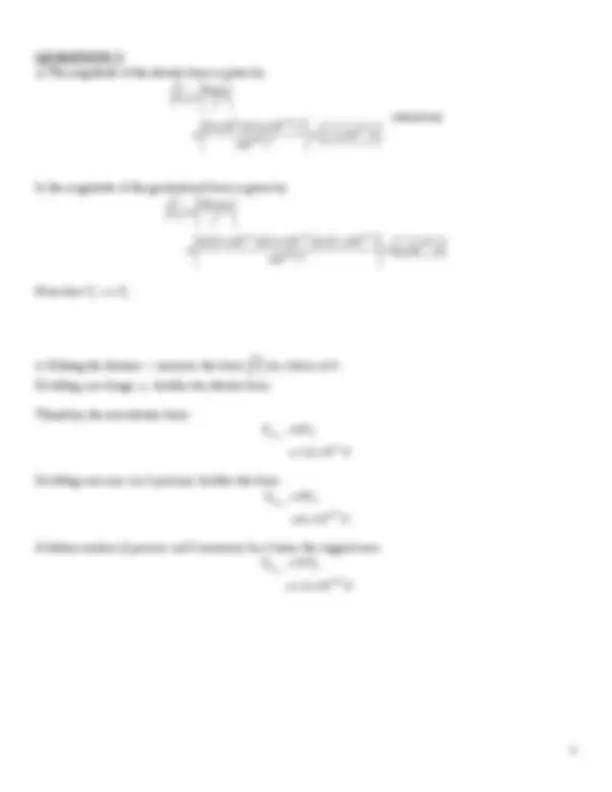
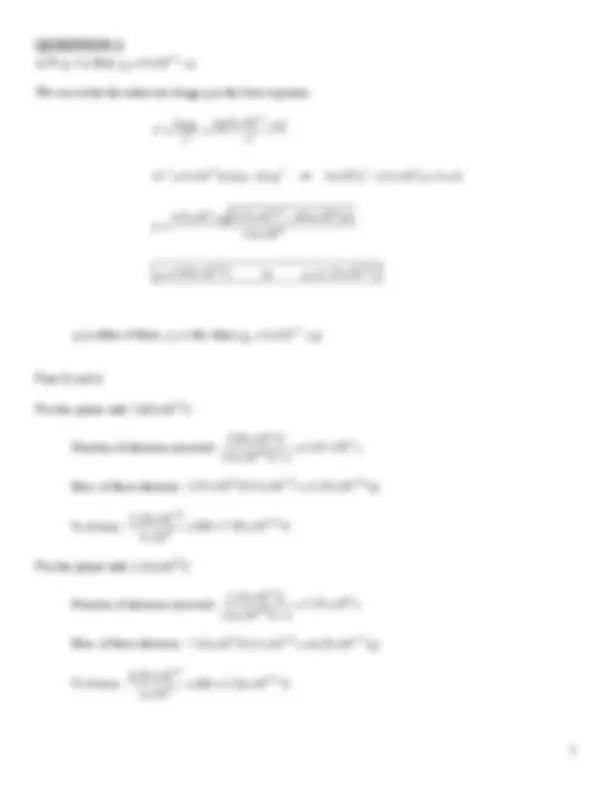
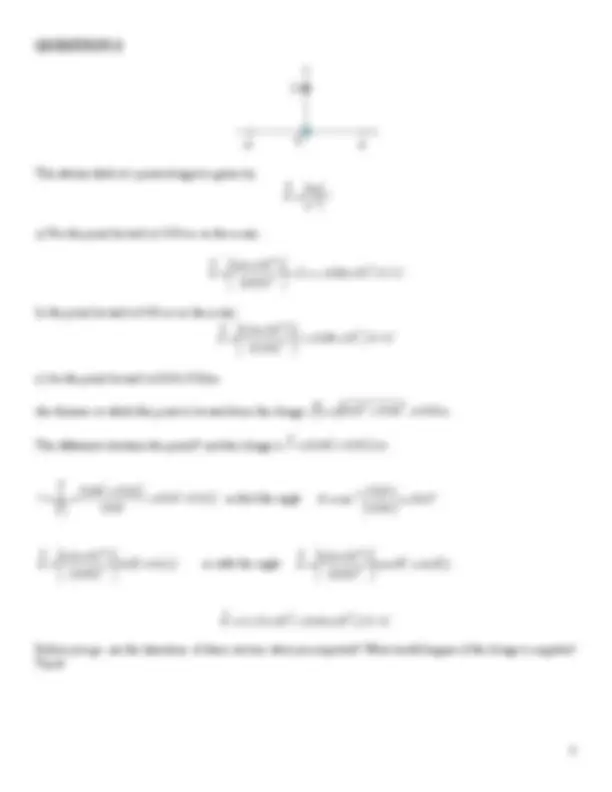
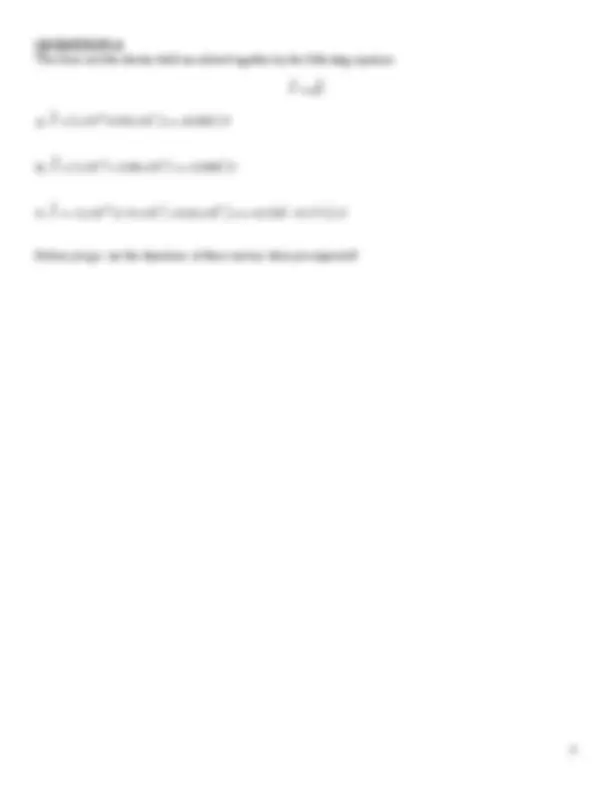
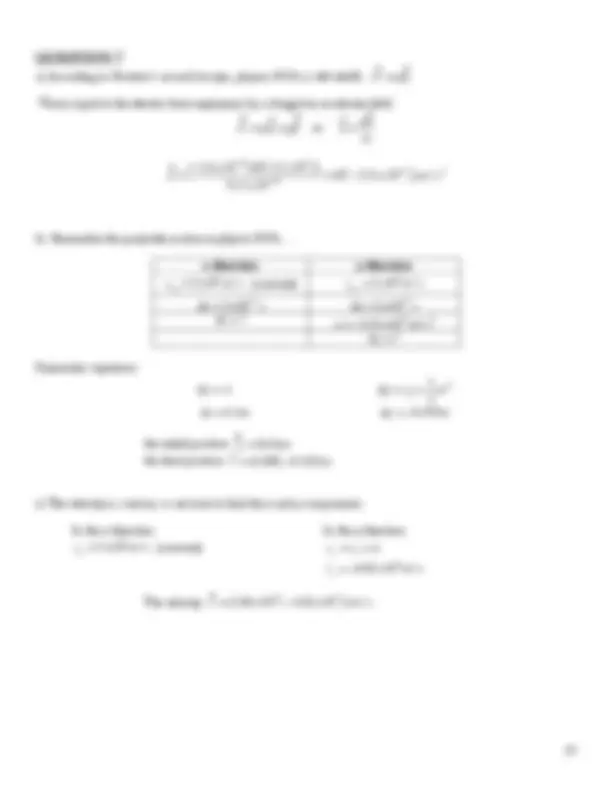
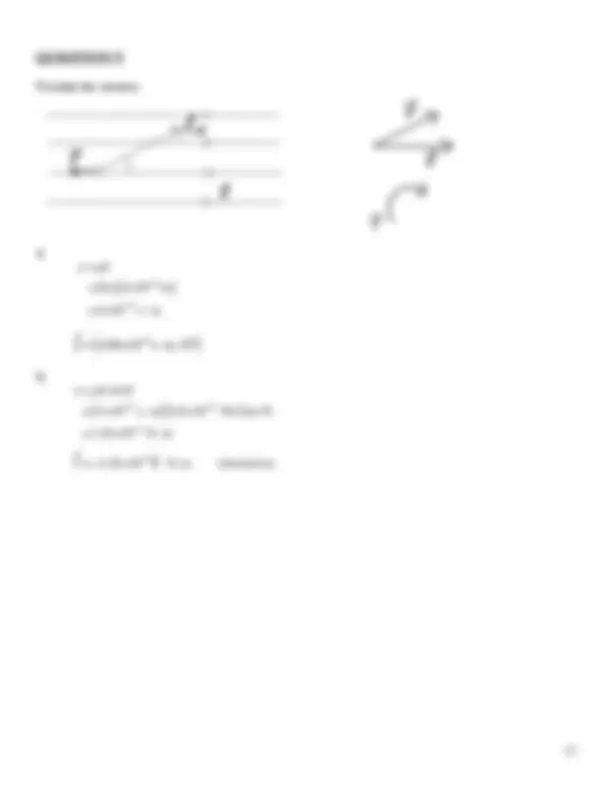
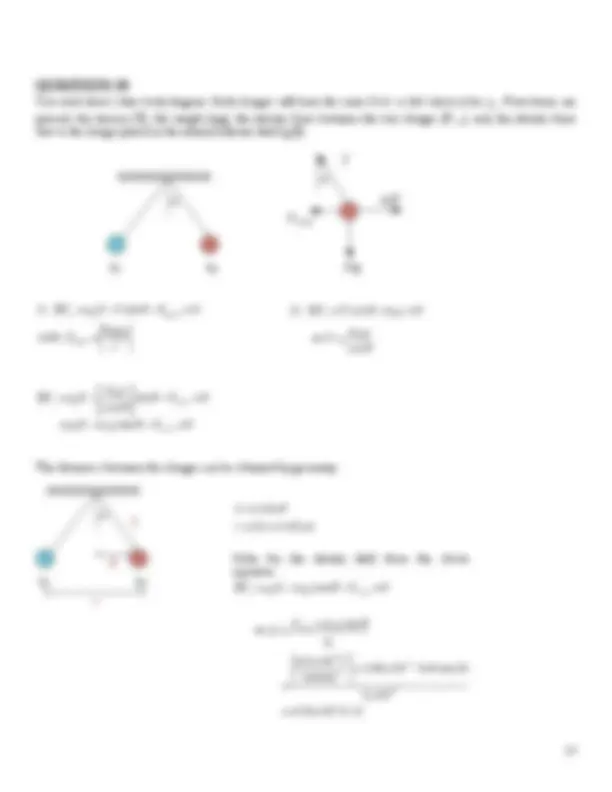



Study with the several resources on Docsity

Earn points by helping other students or get them with a premium plan


Prepare for your exams
Study with the several resources on Docsity

Earn points to download
Earn points by helping other students or get them with a premium plan
Community
Ask the community for help and clear up your study doubts
Discover the best universities in your country according to Docsity users
Free resources
Download our free guides on studying techniques, anxiety management strategies, and thesis advice from Docsity tutors
SOLUTIONS: PROBLEM SET 1. ELECTRIC FORCE AND ELECTRIC FIELD. PART A: CONCEPTUAL QUESTIONS. C. Charges in the uncharged sphere respond to the electric field ...
Typology: Lecture notes
1 / 15

This page cannot be seen from the preview
Don't miss anything!










C. Charges in the uncharged sphere respond to the electric field produced by the charged sphere. The two halves of
the uncharged sphere become equally and oppositely charged, with the side close to the charged sphere having
the opposite charge to the charged sphere. The side closer to the charged sphere gets attracted and the side
further gets repelled, but the attractive force is greater (F ∝ 1/r
2
, r smaller for the closer side). Therefore, the net
force is attractive.
The instant the sphere touch, charges flow from one sphere into the other (they are metal and conduct charges
easily), making them both charged similarly. Like charges repel, therefore they get pushed apart.
We know that afterward both spheres are charged with the same charge, but we have no way of knowing if they
are positive or negative. If the charged sphere had been positive, then electrons would have flowed into it from
the uncharged sphere, making it less positive and the other sphere positive. If the charged sphere had initially
been negative, electrons would have flowed from it into the uncharged sphere, making it less negative and the
other sphere negative as well.
a) Different clothing fabrics have different affinities for electric charges. When rubbed together, some clothing
items tend to grab electrons from others, making some negatively charged and some positively charged. As a
result, the oppositely charged items attract each other. By the way, since charged objects will also be attracted to
neutral objects (see question C), charged clothing will also be attracted to human legs, arms, etc. (Oh, the
heartbreak of static cling!)
b) The effect would be much smaller, since there would be less tendency for charges to be transferred if all the
material had the same affinity for electrons. (Try this at home!)
c) For the same reason discussed in a), bits of clothing become charged as they rub together. If the charge build-
up is sufficient, there might be a spark as the electrons jump back across space. (This is referred to as dielectric
breakdown , when the electric field magnitude becomes stronger than the dielectric strength of the medium between
the charges. In this case that medium is air; dry air has a dielectric strength of 3x
6
N/C. Descriptively, what
happens is this: the electric field is so strong that electrons are pulled free from the negatively charged piece of
material. These electrons crash into molecules of air, ionizing them and liberating even more electrons.
Essentially, we end up with an avalanche of charge, and the air conducts electrons from the negative to the
positive material. This happens with amazing quickness. The air is suddenly heated and expands, causing the
sound. As the electrons recombine with the ionized atoms in the air, light is emitted. If this description sounds a
lot like thunder and lightning, that’s essentially what it is, on a tiny scale.)
d) Water molecules are polar. Warm, humid air contains a large number of these polar molecules. The polar
molecules tend to steal excess charge from a charged object, making it difficult for any material to accumulate a
significant amount of excess charge.
E. a) F. b) G. d) H. c)
a) The magnitude of the electric force is given by:
1 2
2
9 19 2
8
10 2
E
kq q
r
−
−
−
r
(attraction)
b) the magnitude of the gravitational force is given by:
1 2
2
11 31 27
47
10 2
G
Gm m
r
− − −
−
−
r
Note that E G
c) Halving the distance r increases the force (^) F
r
by a factor of 4.
Doubling one charge q , doubles the electric force
Therefore, the new electric force:
7
new
E E
−
Doubling one mass (i.e 2 protons) doubles the force.
47
new
G G
−
A helium nucleus (2 protons and 2 neutrons) has 4 times the original mass.
46
new
G G
−
a) If 1
5
2
q 5 10 q
−
= × −
We can isolate the unknown charge q in the force equation.
5
1 2
2 2
2 5 2 9 2 5
5 5 2 9
10
5 5
3.85 10 or 1.15 10
kq q kq q
r r
Fr k q k q q q
q
q C q C
−
−
− −
1
q is either of these; 2
q is the other (
5
2
q 5 10 q
−
= × − )
Parts b) and c)
For the sphere with
5
−
Number of electrons removed:
5
14
19
−
−
Mass of these electrons:
14 31 16
2.47 10 (9.11 10 ) 2.25 10 kg
− −
× × = ×
% of mass:
16
12
3
−
−
−
For the sphere with
5
−
Number of electrons removed:
5
13
19
−
−
Mass of these electrons:
13 31 17
7.19 10 (9.11 10 ) 6.55 10 kg
− −
× × = ×
% of mass:
17
12
3
−
−
−
According to situation 2:
1 3 2 3
1 3 2 3
2 2
2 2
1 2
2
1 2 1 1
6 2 5 4
on on
kq q kq q
x x
q x q x
q q x q x q
x x
− − −
r r
Using the quadratic equation (again… it might be a good idea for you to remember it!)
5 5 2 6 4
6
3.80 cm or 14.2cm
x
x x
− − − −
−
3
q to the right of 2
q. Which of course
makes no sense! The reason it came about is that the equation doesn’t consider the fact that 2 on 3
r
changes direction
as x gets bigger than 6 cm.
So the charge 3
q must be placed between the other charges, 3.80 cm from the 3μC charge.
N.B. This problem could have been solved equivalently by finding the point P at which the electric field due to 1
q
and 2
q is zero ( 1 2
P P
r r
). Why?? Try it!
The electric field of a point charged is given by:
2
kq
E r
r
r
a) For the point located at - 0.03 m on the x-axis:
6
7
2
k
E i i N C
−
×
r
b) the point located at 0.03 m on the y-axis:
6
7
2
k
E j j N C
−
×
r
c) for the point located at (0.04; 0.03)m:
the distance at which this point is located from the charge:
2 2
r = 0.03 + 0.04 =0.05 m
r
The difference between the point P and the charge is
r = (0.04 i +0.03 ) j m
r
r i j
r i j
r
r
r
or find the angle
1
tan 36.
6
2
k
E i j
−
×
r
or with the angle:
6
2
(cos sin )
k
−
×
r
7 6 ˆ ˆ E = (1.15 × 10 i + 8.64 × 10 j N ) / C
r
Before you go: are the directions of these vectors what you expected? What would happen if the charge is negative?
Try it!
That is equal to the electric force experience by a charged in an electric field:
19 2
13 2
31
−
−
b) Remember the projectile motion in physics NYA….
x-direction y-direction
6
2 10 / ox
v = × m s (constant)
6
3 10 / oy
v = × m s
7
−
7
−
Δ x =?^13
Kinematics equations:
Δ x = vt
2
o
Δ y = v t + at
o
c) The velocity is a vector, so we have to find the x and y components:
In the x-direction: In the y-direction
6
2 10 / x
v = × m s (constant) y o
v = v + at
6
4.02 10 / y
v = − × m s
The velocity:
6 6 ˆ ˆ v = (2.00 × 10 i − 4.02 × 10 j m ) / s
r
We first have to find the x and y components of the velocity vector:
6 6 6 ˆ ˆ ˆ ˆ v = (6.00 ×10 cos 45 i + 6.00 ×10 sin 45 ) j = (4.24 i + 4.24 ) j × 10 m / s
r
a) In the y-direction:
y
y y y y
19 3
14 2
31
y
−
−
6
4.24 10 / oy
v = × m s
Δ t =?
2
oy y
Δ y = v t + a t solve for the time t…..
2 6 14 2
14 2 6 2
t t
t t
−
−
Solve using the quadratic equation…
6 6 2 14 2
14
9 8
6.46 10 or 1.77 10
t
t s t s
−
− −
The time
9
−
8
−
plate after
9
−
How far has it moved horizontally in that time?
In the x-direction
6
4.24 10 / ox
x
x
r
9
−
6 9 2
4.24 10 (6.46 10 ) 2.74 10
ox
x v t
m
− −
Visualize the situation:
a)
10
10
1e 4 10 m
4 10 e m
p qd
−
−
10
−
b)
10 16
24
sin
4 10 e m 4.8 10 N/e sin 35
1.10 10 N m
pE
− −
−
25 ˆ 1.10 10 N m (clockwise)
−
= − × ⋅
r
You must draw a free body diagram. Both charges will have the same f.b.d. so let’s draw it for 2
q. Four forces are
present: the tension [T], the weight [mg], the electric force between the two charges [F 1on
] and, the electric force
due to the charge placed in the external electric field [q 2
2 1 2
1 2
(^1 2 )
with
x on
on
F q E T F
kq q
r
2
2
cos
y
F T m g
m g
θ
θ
2
2 1 2
2 2 1 2
sin 0
cos
tan 0
x on
on
m g
F q E F
q E m g F
The distance r between the charges can be obtained by geometry.
sin
d L
r d cm
Solve for the electric field from the above
equation:
2 2 1 2
1 2 2
2
8 2
3
2
8
5
tan 0
tan
2.00 10 9.81tan
x on
on
F q E m g F
F m g
q
k
−
−
−